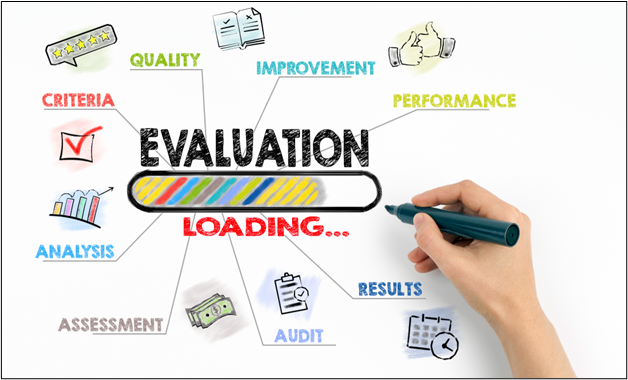Evaluation Form: Evaluating Employee Performances Through Forms
Introduction
Most professionals will come across an evaluation form at some point in their employment, whether as the one assessing another or as the person being reviewed. Depending on who prepares the form, evaluations may need the evaluator's identity or be anonymous, and they may be in paper copy or digital form. Learning more about these papers might assist you as a manager, drafting one, or better understanding your own evaluation as a team member.

In this post, we will discuss what an evaluation form is, what it is used for, what fields are commonly seen in such a form, and some advice for constructing or filling out the form.
What is an Evaluation Form?
An evaluation form is a document or tool used to gather feedback and assess the effectiveness of a particular product, service, program, or event. The form typically includes a set of questions or prompts that are designed to collect both qualitative and quantitative data about the subject being evaluated.

Evaluation forms may be used by businesses, educational institutions, government agencies, non-profit organizations, or individuals to gather feedback and assess the success of their activities. For example, a business may use an evaluation form to collect feedback from customers about a new product or service, while an educational institution may use an evaluation form to gather feedback from students about a particular course or program.

The questions on an evaluation form may vary depending on the purpose of the evaluation and the specific subject being evaluated. Common types of questions include rating scales, open-ended questions, multiple-choice questions, and Likert scales. The information collected through evaluation forms can be used to make improvements, refine processes, and make decisions about future activities.
What is an Evaluation Form used for?
An assessment form is a tool for providing comments on people. They can speed up the feedback process because the questions in the form are common and the evaluator offers comments on comparable topics. Managers typically utilize the form's data to assess team productivity and evaluate how their employees are performing during the yearly performance review. Some firms may need employees to receive positive feedback from their coworkers in order to be promoted or receive pay raises.

Some forms may be anonymous in order to obtain more honest input. People may feel safer and less concerned if their comments cannot be traced back to them. However, anonymous input has the disadvantage of being untrue. The individual being assessed may also be unable to contact the evaluator to resolve any disagreements.
What is the Purpose of an Evaluation Form?
An evaluation form provides the company's appraisal of its staff. It provides relevant information that might assist the organization in making decisions regarding staff promotions, salary hikes, and layoffs. Employers also use an assessment form to identify the strengths and flaws of their staff. An employee self-evaluation is a document used by employees to assess their own performance. This is vital when mentioning your accomplishments.
Benefits of an Evaluation Form
The benefits of evaluation forms are numerous and can vary depending on the context in which they are used. Here are some examples of who may benefit from evaluation forms:
1. Businesses: A business may use an evaluation form to gather feedback from customers about a new product or service. The information collected through the evaluation form can be used to make improvements to the product or service and to inform future marketing strategies.

2. Educational Institutions: Educational institutions may use evaluation forms to gather feedback from students about a particular course or program. This information can be used to make improvements to the course or program and to inform future curriculum development.

3. Non-profit Organization: Non-profit organizations may use evaluation forms to gather feedback from stakeholders about the effectiveness of their programs or services. This information can be used to refine their programs and services to better meet the needs of their stakeholders.

4. Individuals: An individual may use an evaluation form to gather feedback about a personal project or event. For example, a person may use an evaluation form to gather feedback from attendees of a party they hosted in order to make improvements for future events. Overall, evaluation forms provide a valuable tool for collecting feedback and improving the quality of products, services, programs, and events.
Common Fields Found in an Evaluation Form
By adding additional questions or input fields, you may tailor the form to your own requirements and goals. The goal of both forms is the same: to gather information. These are some of the most popular fields in an assessment form.

a) Name
This field might be used to collect the evaluator's name. It might also gather the name of the individual being reviewed. If the assessment is anonymous, the evaluator may choose to leave their name blank in order to avoid being recognized.
b) Department
This field, once again, may refer to either the evaluator or the individual being assessed. When compiling feedback for evaluation, stating your department helps. Because the reviewer may not be familiar with all the employees at the firm, it may be more efficient to sort the employees by department before analyzing the input.
c) Contact Details
This field is about the evaluator. Providing your contact information may simplify follow-ups following the evaluation and assist in resolving any disagreements between the evaluator and the individual being assessed. It also guarantees that the evaluator is held accountable for any comments provided in the form.
d) Manager
This field may be beneficial in indirectly assessing the manager's effectiveness. Employees working under a certain manager may have a track record of receiving high scores during performance assessments, which may indicate that the manager manages his workers well. It could be beneficial for this manager to discuss personnel management strategies with other teams.
e) Improvement opportunities for the individual being evaluated
A performance evaluation entails gathering information regarding some examples of desirable modifications and enhancements, in addition to gaining positive feedback. In this part, the evaluator expresses their hopes for the person being assessed to improve in order to be a better employee in the future. If you want to keep your survey free of open-ended questions, you may skip this part.
f) Achievements of the individual being examined
In this part, the evaluator may mention all the positive aspects of the individual being evaluated. Include examples of good work or remarkable achievements here. This part may differ depending on the evaluation. This part might be an open-ended question or a multiple-choice question. Alternatively, the form author may have included a scale on which the evaluator could assess the individual being evaluated.
g) General Comments
This field adds some pliability to the form. Including an area for general remarks may be beneficial, since it allows the evaluator to contribute additional feedback about the individual being assessed that the form author may not have considered. Some assessors may also take advantage of this chance to congratulate or thank the individual being evaluated. These remarks might be really positive and motivate the individual being evaluated to strive even harder.
h) Rating Scale
If the form asks the evaluator to select a number on a scale, it almost always includes a rating scale as well. This rating system assists the evaluator in making decisions and maintaining consistency in evaluating personnel. A five-point scale is commonly used since it is intuitive and not unduly taxing, although other values are acceptable as well. If you want your evaluator to avoid giving average evaluations to all employees, use an even-numbered rating scale.
What is an Employee Evaluation Form?
An employee evaluation form is a document used by employers to assess the performance of their employees. The form typically includes a series of questions or prompts that encourage managers to provide feedback on an employee's strengths, weaknesses, and areas for improvement.
The purpose of an employee evaluation form is to provide constructive feedback to employees so they can better understand their performance and make adjustments to their work. The form is also used to track employee progress over time and to identify areas where additional training or support may be necessary.

Employee evaluation forms are often used as part of an ongoing performance management system within an organization. The forms can be used to set goals and expectations for employees and to track progress toward those goals over time. Overall, employee evaluation forms can help employers improve employee performance, increase employee satisfaction, and create a more productive and efficient workplace. They are an important tool for managing and developing a company's workforce.
Key Elements to Include in a Performance Evaluation Form

A performance evaluation template must have a number of essential components in order to work properly. Some of the essential components of a performance evaluation form are as follows:
a) Employee Strengths
The goal of the employee feedback process is to identify both good and negative aspects of their current performance. However, if you create your employee evaluation form to showcase an individual's greatest talents rather than one that focuses on what they haven't been able to perform, your HR will provide excellent outcomes.
b) Score based assessment
Scorecards are used by certain businesses to offer employee feedback. It's a useful technique for evaluating employee contributions on a scale rather than an absolute statement. A scorecard might be used to assess work quality, communication skills, productivity, and other aspects of doing a certain job.
c) Areas of Improvement
A basic list of flaws is far from motivating. A good performance evaluation form, on the other hand, should concentrate on areas where an employee might potentially improve in the future. This section of the performance report should contain specific suggestions for individuals to improve their presentation skills.
d) Qualitative Reviews
Although quantitative, score-based appraisals are wonderful, work success might be abstract depending on an employee's function. While it is simple to quantify the effectiveness of sales and marketing teams using data, measuring the job of a designer is difficult. Qualitative evaluations are used to assess factors such as punctuality, collaboration, initiative, cultural fit, and others.
e) Performance Triggers
Organizations must choose between rewarding and retraining employees based on their performance. An excellent performance evaluation form should feature rule-based process workflows that launch a process based on pre-built specifications, rather than performing everything manually.
f) 360-degree Feedback
Employees in today's fast-paced environment deal with a variety of other stakeholders on a daily basis to do their tasks. In order to obtain a comprehensive appraisal of their performance, firms must consider numerous views, such as contacts with managers, direct reports, customers, and peers.
g) Additional Suggestions
Employees should be given specific feedback on what extra abilities they might learn to improve their performance at work. The HR staff can enable training and development options that can increase the skills and competencies of the relevant worker based on the data collected by an employee assessment form.
Popular Evaluation Form Template
A) Presentation Evaluation Form
A Presentation Evaluation Form is a document used to assess the effectiveness of a presentation, such as a speech, lecture, or seminar. The form typically includes a series of questions or prompts that encourage attendees to provide feedback on various aspects of the presentation, such as the content, delivery, and visual aids.
The purpose of a Presentation Evaluation Form is to provide constructive feedback to the presenter so they can better understand the strengths and weaknesses of their presentation style and make adjustments to future presentations. This form is also used to identify areas where additional training or support may be necessary to improve the presenter's skills.

Presentation Evaluation Forms are often used by educational institutions, corporations, and other organizations as part of their training and development programs. The forms can be used to assess the effectiveness of presentations delivered by both internal and external speakers and to track progress over time.
Overall, Presentation Evaluation Forms can help presenters improve their communication skills, increase audience engagement, and create more impactful presentations. They are an important tool for enhancing professional development and learning.
B) Student Evaluation Form
A Student Evaluation Form is a document used by educators or instructors to assess the academic performance and progress of students. The form is typically used at the end of a course or semester and includes questions that prompt students to provide feedback on various aspects of the course, such as the curriculum, teaching methods, and learning environment.
The purpose of a Student Evaluation Form is to gather feedback from students about their experience in the course and to identify areas for improvement in the curriculum, teaching methods, or other aspects of the learning environment. The form can also be used to provide instructors with insight into how they can better support student learning and to help administrators evaluate the effectiveness of the course.

Student Evaluation Forms can be used at all levels of education, from primary schools to universities. They are an important tool for educators to gather feedback from their students and to make data-driven decisions that improve the quality of education. Overall, Student Evaluation Forms play an important role in promoting student success and ensuring that educational institutions provide a high-quality learning experience for all students.
C) Employee Evaluation Form
An employee evaluation form is a document used by businesses to evaluate their employees' performance. Typically, the form has questions or prompts that urge supervisors to offer feedback on an employee's strengths, flaws, and opportunities for progress. Employee assessment forms are frequently employed as part of an organization's continuous performance management strategy. The forms may be used to establish objectives and expectations for employees as well as measure their progress toward those goals over time.
D) Performance Evaluation Form
A Performance Evaluation Form is a document used by employers to assess the performance of their employees. The form typically includes questions and prompts to evaluate various aspects of the employee's work, such as job knowledge, quality of work, productivity, communication skills, teamwork, and initiative.

The purpose of a Performance Evaluation Form is to provide constructive feedback to employees, to help them understand their strengths and weaknesses, and to identify areas where they can improve their performance. The form can also be used to document an employee's progress over time and to provide a basis for making decisions about promotions, pay raises, or disciplinary actions.

Performance Evaluation Forms are typically completed on an annual or semi-annual basis and are an important part of the performance management process in many organizations. They provide a structured and objective way for employers to evaluate their employees and ensure that they are meeting their job expectations.
Overall, Performance Evaluation Forms play an important role in promoting employee growth and development, and in ensuring that organizations are able to achieve their goals and objectives.
Q/A
Here are some frequently asked questions on Evaluation Forms:
1. What is the purpose of an evaluation form?
The purpose of an evaluation form is to provide feedback and assess the performance of individuals, organizations, products or services, and events.
2. Who benefits from evaluation forms?
Evaluation forms benefit a wide range of stakeholders, such as employees, managers, event organizers, program coordinators, and customers by providing valuable feedback, improving performance, and identifying areas for improvement.
3. What types of evaluation forms are there?
There are different types of evaluation forms, including employee evaluation forms, performance evaluation forms, event evaluation forms, course evaluation forms, product/service evaluation forms, and many more.
4. How are evaluation forms typically used?
Evaluation forms are typically used to collect data from respondents, analyze the results, and use feedback to make informed decisions or improve performance. They may be administered through paper forms or online surveys.
5. What should be included in an evaluation form?
An evaluation form should include questions or prompts that are relevant to the purpose of the evaluation. It should be clear, concise, and easy to understand. The questions should be focused on specific areas that are being evaluated and should provide a range of response options.
6. How do you ensure that the evaluation form is effective?
To ensure that the evaluation form is effective, it should be designed with the end-user in mind and should include clear and concise questions that are relevant to the purpose of the evaluation. The form should be tested with a small group of individuals to identify any issues or areas for improvement.
Conclusion
Creating the ideal evaluation form does not have to be a difficult effort. It begins when you determine which tool will assist you in running the procedure. Although pre-designed performance review templates in packaged HR software assist firms in getting off to a good start, its lack of flexibility just adds to the total complexity.

Unlike other all-in-one HR suites, LeadGen App offers evaluation form templates that can be tailored to their own company processes. You can choose from 500+ templates or create your own form from scratch. You can customize your form with the available themes, add your brand logo, use the most advance features, and much more. Are you looking for a versatile performance evaluation form? Sign up for a free LeadGen App trial and see why it's the leading form builder tool!







